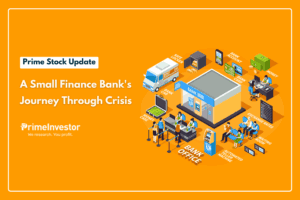For those of you spooked by the continuing volatility in debt funds, our earlier article would have explained why these ups and downs prevail now. If you have money to be deployed or profits booked out of equities and waiting in the sidelines, you may hesitate to deploy it in this debt market condition.
To speak the truth, there are no categories other than overnight and liquid that are spared from the current volatility. However, if one looks at it on a relative basis, select funds from ultra-short, low duration and money market have held on, notwithstanding the see-saw.

In this report, we cover 2 funds from our Prime Funds that may fit your requirement of low volatility for money to be deployed for short duration. They are Nippon India Money Market – a money market fund and Axis Treasury Advantage – a low duration fund.
Before we move to explaining about the funds and how to use them, note the following:
- We do not recommend a switch from any of your other debt fund holdings (provided you have checked their quality in our review tool) to these funds. The yields on these funds are not attractive and are just keeping their head about similar tenure FDs. The only difference is that these funds will readjust to higher levels faster while you will stay locked in at lower rates with FDs.
- We retain our debt outlook for 2021 and think a combination of ultra-short (or low duration), short duration and floater funds will provide superior returns over a 1–2-year time frame than just very short duration funds. However, short duration funds and floater funds will come with negative returns in the short term. You should opt for the funds recommended here only if you cannot take such monthly losses in debt funds now.
Nippon India Money Market
Nippon India Money Market is money market fund, investing in instruments that mature in a year or less. The instruments may be treasury bills, commercial papers issued by companies, certificates of deposits or even gilts, all with maturity of less than a year. The fund’s current portfolio does not have any papers below A1+ or below AA+.
If you merely go by the yield to maturity (YTM), Nippon India Money Market is not the highest yielding in its category, although it stands among the top 5. However, what needs to be noted is that its YTM is steadily creeping up as can be seen from the below graph.
The fund stands out for relatively lower volatility than peers in the money market, low duration, ultra-short and floater categories. In this universe, the fund scores lowest on monthly standard deviation (i.e, it is very low volatile); UTI Money Market and Kotak Money Market are at par with this fund on this score.
What this means is that in times such as the present one, the fund’s ability to contain declines is high. The fund has slipped into weekly negative returns just 0.8% of the times, compared with an average 4% (when returns were rolled weekly for the past 5 years), if you take all the categories mentioned above.
The current average maturity of this fund is 107 days or a little over 3 months. Unlike peers in other shorter duration categories, the fund has not seen any negative monthly returns since January 2021.
Axis Treasury Advantage
This low duration fund is marginally more volatile than the Kotak Money Market fund. It sports a higher yield to maturity for 2 reasons: one, low duration funds need a minimum 6-month Macaulay duration, contrary to money market funds which can have any duration up to a year. Second, low duration funds are not restricted in terms of the kind of instruments they can hold or their ratings.
Axis Treasury Advantage’s yield to maturity at 4.16% is lower than many other peers – but many of which hold some lower credit instruments below AA+. The fund too holds papers below AA+ but that presently accounts for less than 7% of its portfolio and are mostly from large houses such as Tatas or Muthoot and small exposure to Aadhar Housing Finance (adequately capitalized after entry of Blackstone group).
The fund, however, has a marginally higher proportion of monthly negative returns (at 4.3% over 5 years). The graph below will tell you the volatility in returns in the 2 funds.
In the past month too, the fund did slip into sporadic instances of negative returns but recovered quickly. This has to do with the wild swing in yields driven by RBI’s open market activity and the market’s negative sentiment driven by a spike in US treasury. Its average maturity as of January 2021 was 257 days.
How to allocate for these debt funds
- If you prefer less volatility stick to Nippon Money Market to park money needed for 3 months to 1 year. If you can handle some volatility, then consider a 30% exposure to the Axis fund and the remaining in Nippon India Money Market.
- A long holding of 6-month plus may provide a better chance to get superior returns if one assumes yields will move up.
- Note that there is no harm in taking higher exposure to Axis Treasury Advantage as it remains part of our recommended list. But since the purpose of this article is to provide options for low-risk investors who are averse to the current volatility, limiting exposure to the more volatile fund of the 2 would be the prudent thing to do.
Comparisons difficult
The return assumption based on yield to maturities (YTM) of funds or the return comparison with FDs for shorter duration funds is often misunderstood. We’d like to clarify on two of such common misconceptions.
YTM and return: Do not assume that your return will be simply the yield less than expense ratio. It may not be for a couple of reasons: for one, the funds have some exposure to gilts/SDLs, debentures that have some mark-to-market movements although they sport short maturity. Besides, instruments like commercial papers are now required to be listed. Both factors will add to the sensitivity of the prices of these instruments as market yields fluctuate.
This can act in their favour or otherwise, depending on the yield movement. For example, Kotak Money Market’s 3-month return now, is marginally higher than its YTM of 3 months ago (average maturity was 3 months then). It clearly says that YTM (less expense) does not simply equal returns. Second, as newer instruments with higher coupons are added for shorter tenure, it can change your return profile if you hold for slightly longer than the maturity profile at which you entered (therefore we recommend a holding over 3 months for better returns).
Comparing with FD: When you compare returns with FD, there can be some slips:
- One, you may be comparing past returns of funds with present FD rates. This won’t give you the right indication.
- Two, even when you compare the YTM with FD (for similar maturity) it may not give you a right picture as mentioned in the earlier point on YTMs.
Let’s take an example with the current FD rates. A 3-month SBI FD rate (other than for senior citizens) is at 3.9% at present (3-month g-sec yield is at 3.17% now). Nippon India Money Market’s YTM, at 3.84%, is lower than the FD rate. However, keep in mind that the returns may be coming in at a higher rate. To explain, if the current 1-month returns are annualized it comes to about 4.1% – higher than the YTM of the past 3 months and higher than the FD rate. This is how returns adjust – either to higher coupons or marginally responding to easing yields.
Again, do not conclude that the returns will be 4.1%! To us internally, the gauge is the yield and the spread (with similar maturity g-sec) more than the YTM.
Since many of you ask us what return to expect, it is important for us to tell you why this is a tricky question to answer (which means please don’t ask us 😊 ), especially when yields fluctuate rapidly. All we can tell you is that these funds may be well-placed to hold up with least volatility until rates settle. If this uncertainty too is not ok with you, short-term FDs are quite fine!







16 thoughts on “Prime Recommendation: 2 Debt funds to limit current market volatility”
I believe there is a risk of negative returns / volatility in debt funds that makes primeinvestor bringing up this report. However, why aren’t you considering arbitrage funds to stay in sidelines ?
Sir, the article is for debt investors to know that debt will have volatility when rates change. On arbitrage – please read this one: https://www.primeinvestor.in/arbitrage-funds-vs-liquid-funds-which-to-invest/ Vidya
Mam, looking at the current interest rates and inflation, is it fair to say that returns from debt mutual funds in the foreseeable future of 1to2years will be in low single digits compared to the stellar returns of yesteryears.
Yes, in the case of duration strategies, if rates move up further. But Accrual (ultra short, short, medium, corp bond etc), will become lucrative. thanks, Vidya
Why is Axis Treasury Advantage compared to Kotak Money Market for volatility ?
Because they both quality as very short term categories. Vidya
Debt funds are a complex beast, your efforts to ease it for our understanding is exemplary. Thanks
Thank you! Vidya
Hi Vidya,
First of all, thanks for an insightful article as always.
I have below 2 queries if you can help with:
1. Can you please explain by providing any specific fund examples (one may be short duration and one may be long duration) from previous rising yield cycle on the point that yield minus expense ratio is not the return to be expected?
I know it is difficult to quantify the returns expected but this will help understand better.
It may require some research on your side but if you or team can please consider this request.
2. What is the source for the YTM history of debt funds? Is it possible to provide historical view of YTM to users?
Thanks,
Romil
1. In the case of Axis Treasury, a yield of 4.25% end Sep20, roughly translates to 1.5% return for the avg maturity then. The returns fr the same period ending feb 23 comes to 1.8% A 30 basis point higher for a short period is significant and came from easing of yields on and off even as the trned was rising.
2. Our source is our database that we are not permitted to publish. We hope to show 3 months of YTM (to see the shift) when we move to a new ‘fund details’ page in a few months. thanks, Vidya
Is it still okay to consider HDFC Floating Rate Fund in lieu of these two funds if the holding duration is longer than 1 year? Thanks.
HDFC Floating Rate is highly volatile (higher duration too) and reason why we have classified it in short term for min 1.5 years and ideally 3 years. thanks, Vidya
In Prime Funds HDFC Floating Rate fund is rated 5 stars along with ABSL fund wnd recommended Buy. If I hadn’t read this post I would have invested in this fund.
Hello Sir, they are for different time periods and we have clearly bucketed them accordingly in Prime funds. Also ‘why this fund’ will give the distinction clearly. Those 2 funds are clearly not low volatile and we have mentioned it there and also in ABSL write up earlier 🙂 thanks, Vidya
Thank you for the detailed analysis of fund as always. Is it a good idea to invest in ABSL floater fund and HDFC short duration fund via SIP over 1 year to build emergency corpus?
An emergency corpus should first have liquid and ultra short for more than half the corpus. Such a portfolio is to save and rpeserve than earn high returns. You can then cosnider the 2 categories you mentioned. You will in our emergency portfolio, we do not have these categories: https://www.primeinvestor.in/portfolios-need-based/ thanks, Vidya
Comments are closed.